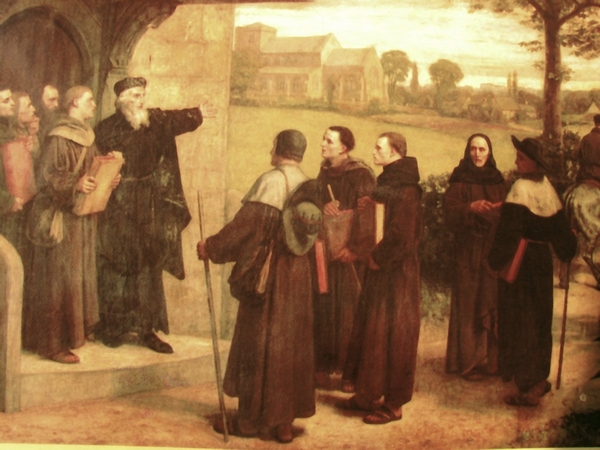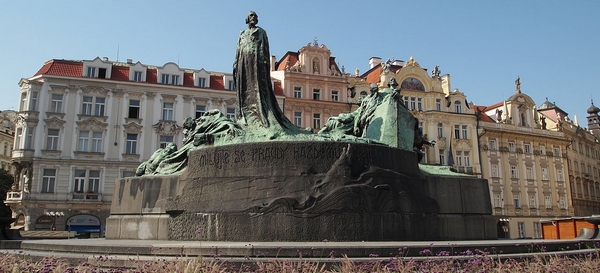Here we will look at the historical background to the Reformation and discuss some of the pre-reformation figures.
You are here: » Christianity in View » Introduction to Protestantism » The Background
 Background to the Reformation
Background to the Reformation
On 31 October 1517, according to traditional accounts, Martin Luther (1483-1546) posted up his 95 ‘Theses’ or discussion points on the door of Wittenburg Cathedral. Luther’s major concern was the corruption in the practice of selling indulgences, defined in the Catechism of the Catholic Church as “…a remission before God of the temporal punishment due to sins whose guilt has already been forgiven.” Indulgences were being sold to reduce (or in some case eliminate) the time that departed souls would have to spend in Purgatory, a place where the departed would go to expiate their sins before admission to Heaven.
Luther’s actions are usually held to mark the beginning of the Protestant Reformation, but they also represent the culmination of a long period of discontent, disquiet and change within Christendom.
 The Papacy and Politics
The Papacy and Politics
Throughout the Middle Ages, the Western church with the Pope at the centre, remained at the heart of European society with significant influence in political affairs. Perhaps the height of papal power came during the pontificate of Innocent III (1198-1216) who argued for complete subordination of the state to the church in his decree Sicut universitatis conditor.
However papal supremacy was undermined by a series of events. An example often cited is the ‘Avignon Captivity’ (1309-1378), in which the French kings disputed with the papacy over succession and located the papal court to France. Following the return of the papacy to Rome in 1378, a schism occurred with rival claimants to the title. Some argued for a doctrine of conciliarity, in which the Pope would be subject to church councils.
Though the dispute was settled by the Council of Constance (1414-1418) which reaffirmed papal supremacy and thus rejected the conciliar theory, a growing sense of nationalism amongst secular rulers meant that the papacy had lost some of its power and influence. Attempts were made to initiate reforms at Constance and also at Florence (1439), but ultimately these proved unsuccessful.
 Pre-Reformation Movements
Pre-Reformation Movements
Demands for reform pre-dated the Reformation itself by several centuries. As an example, reforms were carried out within the monastic order at Cluny in the 10th and 11th centuries with the aim of dealing with corruption and reducing the influence of the secular or feudal lords in influencing monastic matters.
 The Waldensians
The Waldensians
The Waldensians (also known as Waldenses) take their name from Peter Waldo, a lay preacher in 12th century France. Waldo gathered together a group of people in Lyons known as the poor men, who devoted themselves to a life of simplicity and poverty. The group sought papal approval in 1179, and were instructed to obey the local clergy in gaining approval to preach. Their refusal to do so led to Papal denunciation as heretics in 1184. The group became more strident in their opposition to the church, opposing such doctrines as purgatory, prayers for the dead and refusing to take solemn oaths. They also denied the full authority of the church to interpret scripture.
The movement spread to other countries, most notably Italy and Bohemia and underwent persecution but survived, particularly in the Piedmont region of Italy. In 1532, William Farel, a friend and associate of John Calvin, met with the Waldenisan leaders and persuaded them to adopt Protestantism, specifically the Reformed tradition.
The movement underwent persecution in France in 1545 which resulted in their virtual elimination from that country. However in 1561, freedom to worship was granted to the Waldensians in Italy. It was not until 1848, that they were granted civil rights.
Today, the Waldensian Evangelical Church comprises over 40,000 members and in 1975 it merged with the Italian Methodist Church to form the Union of Methodist and Waldensian Churches.
 John Wycliffe (c.1324-1384)
John Wycliffe (c.1324-1384)
John Wycliffe was born in Yorkshire around 1324. He was educated at Oxford University and at some point between 1366 and 1372, received his doctorate in theology. Wycliffe’s profile was raised when in 1374 he took part in a dispute between Pope Gregory XI and Edward III of England over tribute payments paid to the Pope. The dispute originally surfaced in 1365, when parliament declared that the Pope had no right to demand such payments and the matter was dropped. Wycliffe argued against the payments, and wrote several articles criticising the power of the church and supporting parliament.
Wycliffe published a work called De Civili Dominio arguing that the authority of any institution depended on grace, and thus could be forfeited when mortal sin was present in that institution.
Wycliffe began to deny the authority of the Pope and also Transubstantiation (the Roman Catholic doctrine that the Eucharistic bread and wine change into the actual body and blood of Christ upon consecration). As a result Wycliffe found himself losing support at Oxford. He also began to send out followers called Poor preachers, who went around the country spreading his views. His overall concern was to see the church imitate the life of Christ more clearly, with a life of a poverty and simplicity.

Wycliffe Giving “The Poor Priests” His Translation of the Bible.
The Church is the totality of those who are predestined to blessedness. It includes the Church triumphant in heaven and the Church militant or men on earth. No one who is eternally lost has part in it. There is one universal Church, and outside of it there is no salvation. Its head is Christ. No pope may say that he is the head, for he can not say that he is elect or even a member of the Church.
In 1378 Wycliffe worked on a translation of the bible into English, but the translation was rejected by the church as being unauthorised and therefore invalid. He also began to gather a group of followers around him, known as Lollards. Eventually in 1382, his teachings were condemned by a church court and Wycliffe was forced to leave Oxford. He settled in Lutterworth, Leicestershire and died in 1384. Because of his desire for reform of the church, Wycliffe is often called the ‘Morning Star of the Reformation’. His views were to have a significant influence on Jan Hus, to whom we now turn:
 Jan Hus (c.1370-1415)
Jan Hus (c.1370-1415)
Jan Hus was born in Bohemia (now called the Czech Republic). The writings of John Wycliffe came to be known in the region and Hus became deeply sympathetic to them. At the time the church was reeling under the Great Schism, with rival claimants to the Papacy. As with Wycliffe, Hus refused to accept papal supremacy and was excommunicated in 1410.
The Great Schism lasted until 1414, when a church council was convened at Constance, Germany. Hus was tried at this council and convicted of heresy. When asked to recant, Hus replied:
God is my witness that I have never taught that of which I have by false witnesses been accused. In the truth of the Gospel which I have written, taught, and preached, I will die today with gladness.
He was burnt at the stake, still protesting his innocence. In 1999, Pope John Paul II formally apologised for Hus’ execution.
A series of conflicts known as the Hussite Wars took place in Bohemia between 1419-1434. The followers of Hus put forth the doctrine of Utraquism , i.e. the view that both the bread and the wine should be given to all during the communion service, rather than restricting the wine to the clergy. This view was accepted by the Roman Catholic Church as part of the ‘compacts’ or agreements ending the wars and lasted until 1567.
Among the alleged last words of Hus is a striking prophecy on the future course of reform:
“In 100 years, God will raise up a man whose calls for reform cannot be suppressed.”

Jan Hus Monument, Prague
 The Renaissance and Humanism
The Renaissance and Humanism
The Renaissance (from the French: ‘rebirth’), which broadly covered the period from the 14th to the 16th centuries, was a powerful movement which had profound effects in the political, philosophical, artistic and religious realms. Humanism could be considered as the worldview underlying the Renaissance. Humanists believed the best models of learning came from the classical Greek and Roman civilizations, a view epitomized in the slogan ad fontes (‘to the fountains’).
In the religious realm, a movement known as the devotio moderna (Modern Devotion) began in the 14th century with the ideas of Geert Groote in the Netherlands. Groote founded a community known as the Brethren of the Common Life in which emphasis was placed on the study of scripture and private meditation and a desire to imitate Christ in simplicity and purity of life.
The movement spread to Germany and other parts of Europe and found its classic expression in Thomas a’ Kempis work The Imitation of Christ, published c.1418. The movement’s emphasis on private rather than communal devotion and the private reading of religious works meant that in some respects, it was a precursor of the Reformation.
A combination of Christian and Humanist ideas was found in the movement known as Christian Humanism. Applying ad fontes as a principle meant a renewed emphasis on the study of scripture as a primary source along with the writings of the early church fathers. Erasmus of Rotterdam (c. 1466-1536) was educated in the devotio moderna, and was committed to Christian Humanism and using ad fontes to promote peaceful reform within the church.
Erasmus produced a version of the New Testament in Greek which appeared in 1516 and thus gave scholars something to compare against the Latin Vulgate. Erasmus vision (despite widespread illiteracy) was that the scriptures be made available to all, as evidenced by his remarks in the preface: “I could wish…that these were translated into each and every language…that the farmer might sing snatches of Scripture at his plough and that the weaver might hum phrases of Scripture to the tune of his shuttle.”
Erasmus’ ideas represented a different approach to method for carrying out reform but his reform programme came to be overshadowed by that outlined by Martin Luther. Thus, as some have put it: “Erasmus laid the egg that Luther hatched.”
 Social Changes
Social Changes
The invention of movable type printing by Johann Gutenburg (c. 1398-1468) was crucial to the propagation of Reformation ideas. Books and pamphlets became much more widely available and literacy grew, particularly in the towns, which themselves were beginning to grow. It also meant that ideas and concepts judged heretical would be harder to control.
Erasmus’ work: Handbook of the Christian Soldier (1503), was an appeal to educated men and women, who Erasmus regarded as the church’s most important resource. The production of Bibles in the vernacular, such as the German Bible (1466) gave impetus to Erasmus’ vision of a Biblically literate laity, despite the fact that vast sections of the population remained illiterate.
The Black Death had led to the death of millions in the 14th century, and people had become increasingly preoccupied with death, but society had begun to recover in the 15th century. The power of the traditional aristocracy was being increasingly challenged by the emergence of an entrepreneurial class which in turn fostered an attitude of individual identity: social position and status could be self-determined by the individual.
 Wise words:
Wise words:
“I believe that in the end truth will conquer.”
John Wycliffe (c.1324-1384).